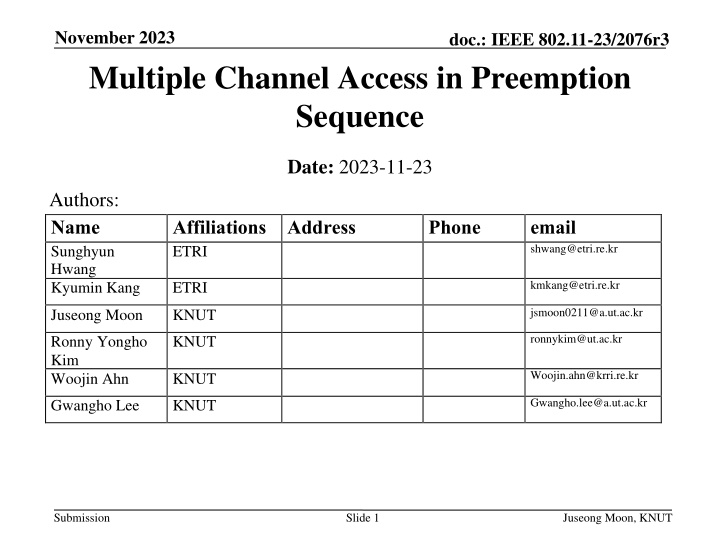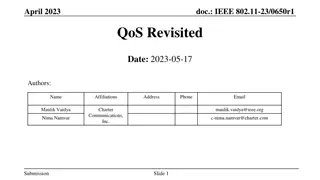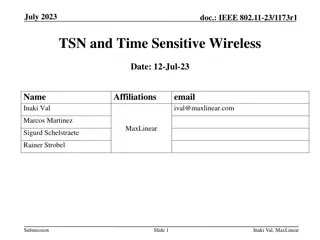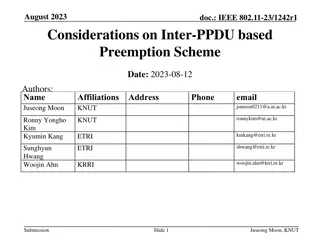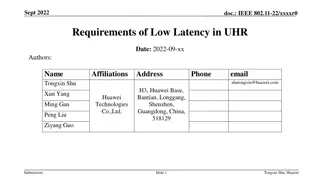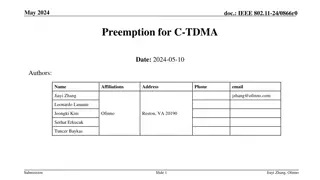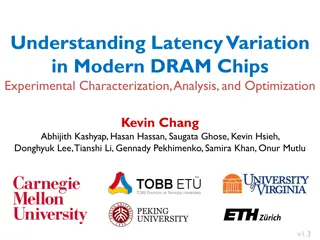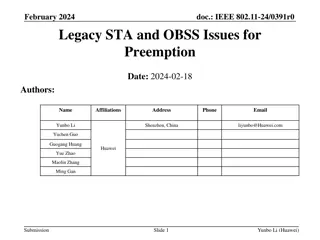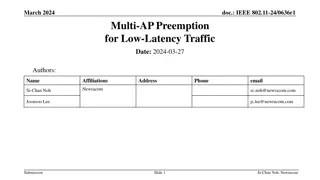Analysis of Preemption Methods in IEEE 802.11-23/2076r3 for Latency Reduction
Discussion on preemption methods in IEEE 802.11-23/2076r3 document focusing on latency reduction objectives. Topics include coordinated preemption, random channel access, comparison between methods, and the impact on STAs performance. The document addresses concerns such as collision probability, coordination overhead, and efficiency based on the number of STAs involved.
Download Presentation

Please find below an Image/Link to download the presentation.
The content on the website is provided AS IS for your information and personal use only. It may not be sold, licensed, or shared on other websites without obtaining consent from the author.If you encounter any issues during the download, it is possible that the publisher has removed the file from their server.
You are allowed to download the files provided on this website for personal or commercial use, subject to the condition that they are used lawfully. All files are the property of their respective owners.
The content on the website is provided AS IS for your information and personal use only. It may not be sold, licensed, or shared on other websites without obtaining consent from the author.
E N D
Presentation Transcript
November 2023 doc.: IEEE 802.11-23/2076r3 Multiple Channel Access in Preemption Sequence Date: 2023-11-23 Authors: Name Sunghyun Hwang Kyumin Kang Affiliations Address ETRI Phone email shwang@etri.re.kr kmkang@etri.re.kr ETRI jsmoon0211@a.ut.ac.kr Juseong Moon KNUT ronnykim@ut.ac.kr Ronny Yongho Kim Woojin Ahn KNUT Woojin.ahn@krri.re.kr KNUT Gwangho.lee@a.ut.ac.kr Gwangho Lee KNUT Submission Slide 1 Juseong Moon, KNUT
November 2023 doc.: IEEE 802.11-23/2076r3 Abstract The tail of latency reduction is one of 11bn s objectives. To improve latency performance, preemption methods were discussed. The preemption methods, in which an AP coordinates preemption, were discussed[1, 2]. STAs transmit pre-emption request frames within an inter-PPDU spacing. Contention resolution phase follows pre-emption request phase. The preemption methods with random access between STAs were also discussed [3]. STAs contend for medium for latency sensitive frame within an inter-PPDU spacing. Once a STA succeed in channel contention, the STA transmits the latency sensitive frame immediately. Submission Slide 2 Juseong Moon, KNUT
November 2023 doc.: IEEE 802.11-23/2076r3 Recap: Coordinated preemption method (Coordination method) [1]: 23/1229r1, Juan Fang Coordination The discussed preemption method uses AP s coordination This method can reserve transmit slots for STAs Collision probability can be decresed However, coordination overhead may occur. Submission Slide 3 Juseong Moon, KNUT
November 2023 doc.: IEEE 802.11-23/2076r3 Recap: Random Channel Access for Preemption (Random Access method) [3] discussed the necessity of random channel access within an inter-frame spacing Collision occurs XIFS SIFS AP DL PPDU DL PPDU (TXOP holder) UL PPDU (Preemption) UL LL PPDU STA 1 Time UL PPDU (Preemption) STA 2 LL frame enqueued LL frame enqueued There are some candidates of random channel access schemes: E.g., DCF-like operation Submission Slide 4 Juseong Moon, KNUT
November 2023 doc.: IEEE 802.11-23/2076r3 Example: DCF-like Backoff Scheme This example is showing one of the random access method for preemption. STAs perform short-term backoff within inter-PPDU spacing (XIFS) XIFS should be long enough to perform backoff operations. Submission Slide 5 Juseong Moon, KNUT
November 2023 doc.: IEEE 802.11-23/2076r3 Comparison between Coordination and Random Access Methods 1. Small number of STAs which perform preemption: When only a small number of STAs perform preemption, the random access method is advantageous for quick transmission as it does not require separate coordination. However, an overhead of the coordination method may occur inefficiency when only a small number of STAs perform preemption. 2. Large number of STAs which perform preemption: When a large number of STAs perform preemption, the coordination method has the advantage of a lower probability of collision and better resource management. However, as the number of STAs performing preemption increases, the probability of collision also rises in the random access method. Therefore, inefficiency can occur when using the random access method. Submission Slide 6 Juseong Moon, KNUT
November 2023 doc.: IEEE 802.11-23/2076r3 Summary In this submission, the two channel access methods for UL SU preemption was discussed 1. Coordination Method 2. Random Access Method In the coordination method, STAs can access channel without collisions Overheads for coordinating STAs will be occurred In the random access method, STAs can access channel without coordination overheads Collisions may occur between STAs Submission Slide 7 Juseong Moon, KNUT
November 2023 doc.: IEEE 802.11-23/2076r3 References [1] 11-23/1229r1: Juan Fang et al., Preemption for low latency application (Follow up), https://mentor.ieee.org/802.11/dcn/23/11-23- 1229-01-0uhr-preemption-for-low-latency-application-follow-up.pptx [2] 11-23/1174r0: Kiseon Ryu et al., TXOP preemption follow up, https://mentor.ieee.org/802.11/dcn/23/11-23-1174-00-0uhr-txop- preemption-follow-up.pptx [3] 11-23/1242r1: Juseong Moon et al., Considerations on Inter-PPDU based Preemption Scheme, https://mentor.ieee.org/802.11/dcn/23/11- 23-1242-01-0uhr-considerations-on-inter-ppdu-based-preemption- scheme.pptx Submission Slide 8 Juseong Moon, KNUT
